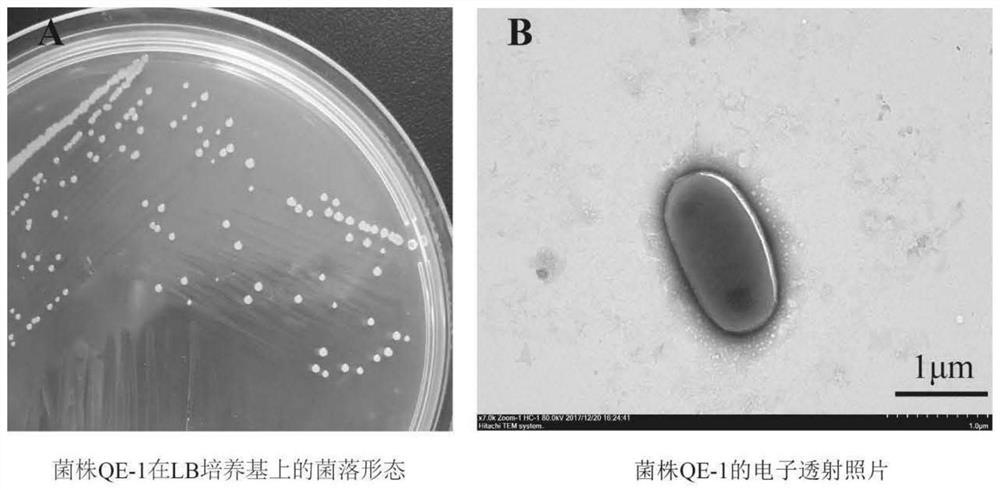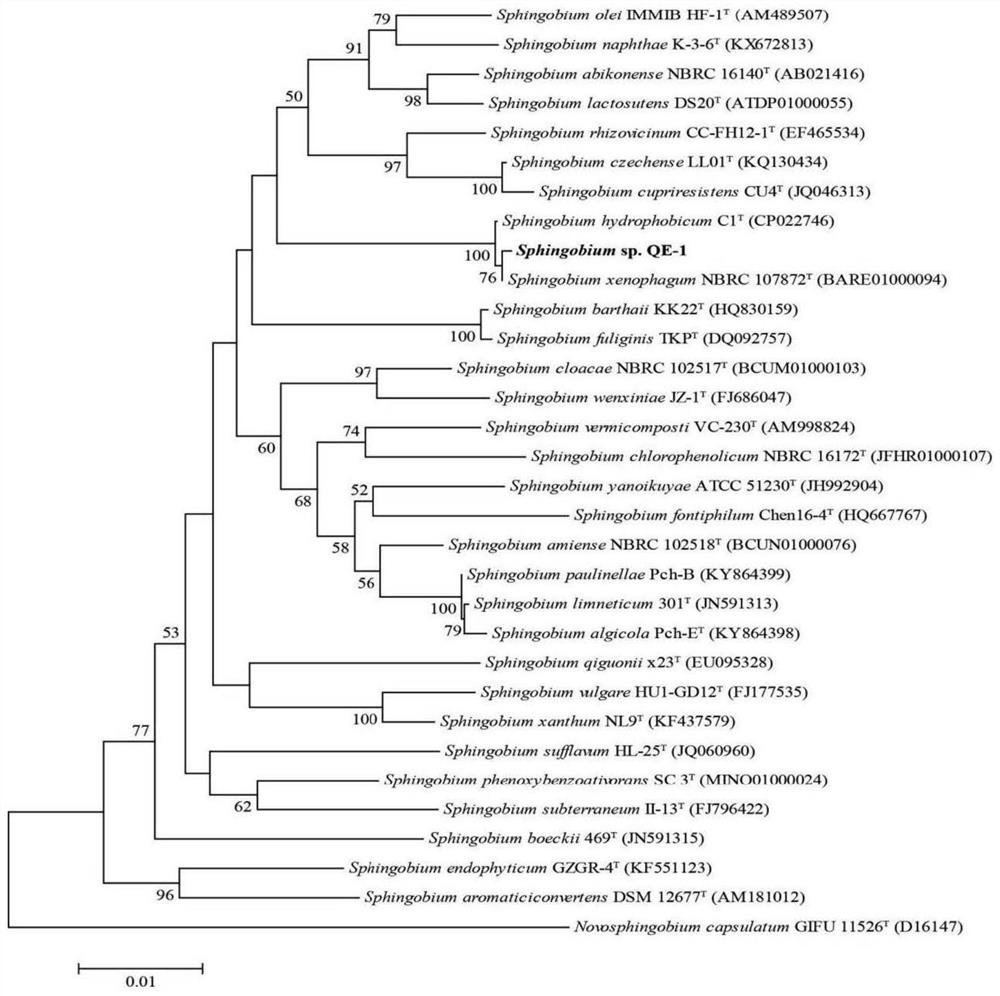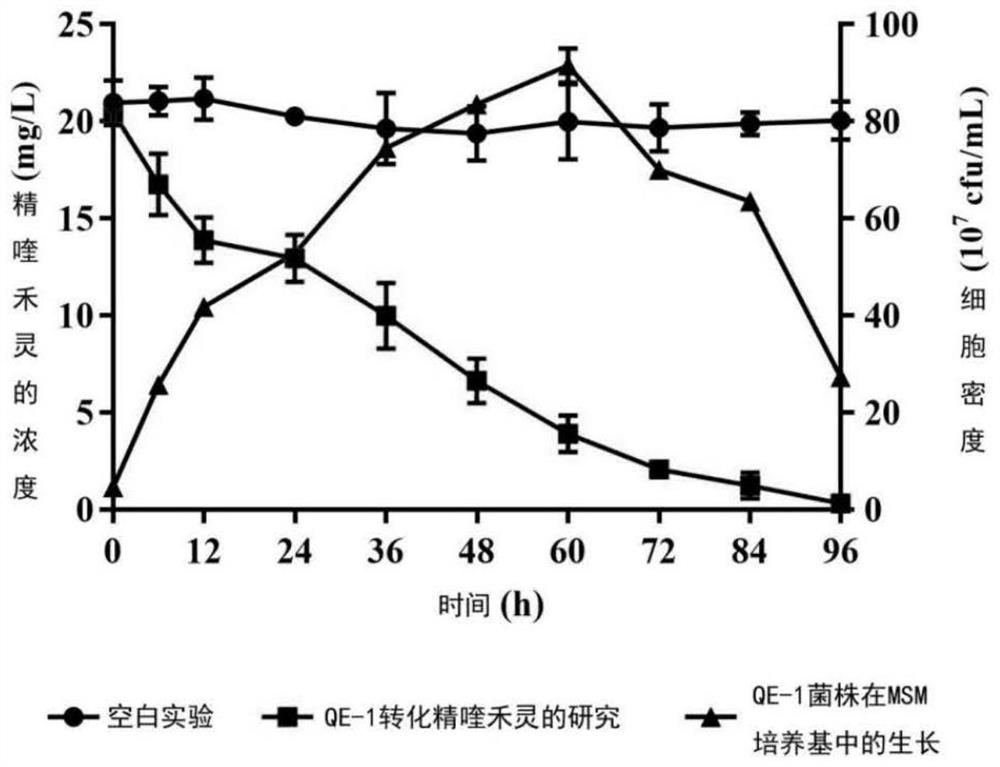Aryloxyphenoxypropionate herbicide degradation strain and fungicide production method thereof
A technology of aryloxyphenoxypropionate and its production method, which is applied in the field of biotechnology, can solve the problems of male reproductive toxicity and damage to rat testicular germ cells, achieve wide application potential and value, solve the problem of excessive pesticide residues, The effect of protecting the ecological environment
- Summary
- Abstract
- Description
- Claims
- Application Information
AI Technical Summary
Problems solved by technology
Method used
Image
Examples
Embodiment 1
[0035] Isolation and identification of aryloxyphenoxypropionate herbicide-degrading strain Sphingobium sp.:
[0036] The invention provides a bacterial strain capable of efficiently degrading aryloxyphenoxypropionate herbicides and the bacterial agent produced by it. The bacterial strain used is Gram-negative bacteria QE-1, named Sphingobacterium, isolated from In the soil of an abandoned pesticide factory in Nanjing, Jiangsu. The specific isolation and screening methods for strains are as follows:
[0037] Take 5.0 g of the soil sample and add it to 100 mL of liquid inorganic salt medium (hereinafter referred to as MSM) containing 30 mg / L quizalofop-p-ethyl, cultivate it on a shaker at 30° C. and 180 rpm for 7 days, and transfer it to In the same fresh medium, enrichment culture was carried out four times in succession. Dilute and spread the fifth-generation enrichment solution on inorganic salt solid medium containing 30mg / L quizalofop-p-ethyl, culture at 30°C for 5 days, ...
Embodiment 2
[0040] Laboratory degradation experiment of aryloxyphenoxypropionate herbicide-degrading strain Sphingobium sp.:
[0041] (1) Preparation of seed solution
[0042] The strain QE-1 was inserted into 100mL LB medium, cultured on a shaker at 30°C and 180rpm, collected by centrifugation at 6000rpm after 48 hours, washed twice with MSM, and finally resuspended with 10mL of MSM, and used as seed solution for later use.
[0043] (2) Degradation of the herbicide quizalofop-p-ethyl by strain QE-1
[0044] The strain QE-1 was inoculated into 100mL MSM containing 20mg / L quizalofop-p-ethyl at a 3% inoculation amount, cultured on a shaker at 30°C and 180rpm, and 3mL samples were taken every 12 hours until the fourth day. The residual amount of quizalofop-p-p-p was detected, the degradation rate was calculated, and the time-degradation curve of the strain QE-1 to quizalofop-p-p herbicide was drawn. like figure 2 , strain QE-1 can degrade 20mg / L quizalofop-p-ethyl within 96h.
[0045] H...
Embodiment 3
[0057] Soil degradation experiment of aryloxyphenoxypropionate herbicide-degrading strain Sphingobium sp.:
[0058] Take vegetable garden soil as the soil sample for testing, pass the soil sample through a 2mm sieve, take a certain amount of quizalofop-p-p, oxaprop-p-p-p and fluazifop-p-p-p powder and dissolve them in 10mL of methanol, and then soak the diatoms Soil, so that the pesticide is completely absorbed. The soaked diatomaceous earth is placed in a fume hood to dry, and it is mixed into the soil so that the concentration of the pesticide in the soil is about 2mg / kg. 500g of each soil sample was cultured in a constant temperature incubator at 30°C, and the inoculum was inserted into the seed solution at an inoculation amount of 10%, and the soil without inoculation was used as a control, and the water holding capacity of the soil was maintained at 60%. After culturing for 7 days, the residual amount was determined by HPLC, and the results are shown in Table 1.
[0059...
PUM
 Login to View More
Login to View More Abstract
Description
Claims
Application Information
 Login to View More
Login to View More - R&D
- Intellectual Property
- Life Sciences
- Materials
- Tech Scout
- Unparalleled Data Quality
- Higher Quality Content
- 60% Fewer Hallucinations
Browse by: Latest US Patents, China's latest patents, Technical Efficacy Thesaurus, Application Domain, Technology Topic, Popular Technical Reports.
© 2025 PatSnap. All rights reserved.Legal|Privacy policy|Modern Slavery Act Transparency Statement|Sitemap|About US| Contact US: help@patsnap.com



